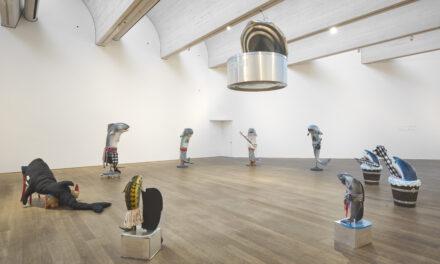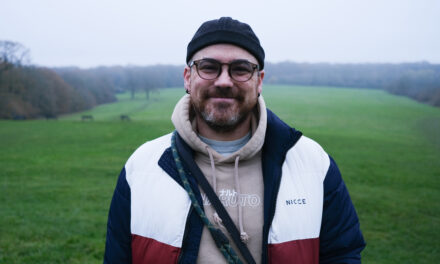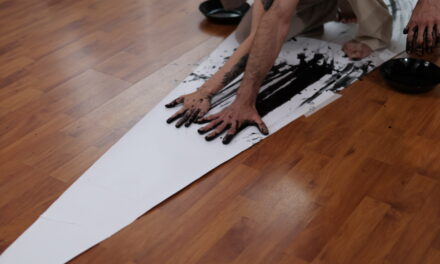Let’s cut to the chase: after laughter, comes tears. “After Laughter Comes Tears” isn’t just the title of a contemporary art exhibit at MUDAM – it’s a mirror to the raw, unfiltered essence of life. And when I say contemporary, I mean it. It’s not easy for the eyes, not easy for the mind. There is a lot happening and do not take it personally, if you get lost or depressed. Because you know what? That’s probably what curators Joel Valabrega and Clémentine Proby had in mind. They’ve orchestrated an exhibit that’s designed to engage you and make you a part of the artistic narrative. Picture this: 34 artists from around the globe, each offering a unique perspective on the world we inhabit. It’s a world fueled by capitalism, with all its complexities and contradictions. Within this exhibit, you’ll find 34 distinct expressions of personal “battles” full of generational anxieties from the climate crisis, xenophobia, homophobia, far-right politics, or mostly capitalist commodification.
“A hard pillow to swallow, a chaotic event, a severed break line, a fetish, a cheap shot, a long exhale, a fatal blow, a pity party, a missed connection, a lack of context, a stolen identity, a cry for help, a sexual frustration, a close call, a best guess, an
unresolved conflict” are some of the tags from an evocative video by Panteha Abareshi (NOT A BODY, 2022), that represent symbolic identities – absent bodies. Physical body, abstract body, post-human body, virtual body, collective body, queer body, bodies of identities … are the themes that I chose to focus on, as it’s impossible to cover the whole plethora of topics brought about by the exhibition of this size and impact. And let’s not forget the vibrant performative program woven throughout the exhibit, an integral part of the experience. Plus, the exhibition is cleverly divided into four acts, complete with a prologue and epilogue. This means that each visit of individual gallery wings offers a fresh perspective, with the artworks rotating in engaging sequences.
The body, our ultimate vessel, holds our identities and represents them in the world. But let’s be real, how many of us truly feel at ease, especially in the face of otherness? Ndayé Kuagou masterfully addresses this in Will you feel comfortable in my corner? (2021), a video performance that sparks a dialogue about safety, belonging, and challenges our gender biases. Jacopo Miliani does it through the power of communication – invented sign language, where he portrays a queer identity without revealing the face of a performer (video Deserto, 2017).
The least body-like, but definitely one of the strongest pieces, at least for me, is the physical installation of Jesse Darling (Reliquary – for and after Felix Gonzalez-Torres, in loving memory, 2022). He literally filled two transparent vitrines with remains of works by Felix Gonzalez-Torres that were recovered from exhibitions at different institutions. They represent both a tribute to Felix’s work Portrait of Ross in L.A. – a metaphorical representation of the artist’s partner’s weight in commercially distributed candy, a partner who died of an AIDS-related illness in 1991, and the institutional waste of materials – discarded artworks, which beautifully illustrates capitalist consumerism in contrast to a very intimate and personal nature of this piece.
Now, don’t get me wrong, I do think capitalism paved the way for various queer identities, but it hasn’t tackled homophobia and transphobia. For many, this often results in economic insecurity, a root issue explored by several artists here. It’s present in a video of Mika Rottenberg (Dough, 2005-06) expressing cheap and gender-specific labor in a creatively absurd way, or a certain cry for help in the video Look! (2021) by Dorian Sari, who applies Beckett’s metaphor of “the waiting for Godot” to the society that ignores many social problems, until their economic impact
is clear. Some artists “escape” into virtual realms, immersing themselves in technology and fiction to convey their message. Sin Wai Kin‘s queer film The Story Cycle (2022) and Sidsel Meineche Hansen‘s VR installation NO RIGHT WAY 2 CUM (2015) fall into this category.
Are we going to be OK? Perhaps, one of the solutions implied here is expected change, a transformation to a socio-economic system, that has the potential to reshape our society and diverge from conventional capitalist norms. In the end, we are in this together, and every voice counts (see the installation Assembly, 2022 by Stine Deja).
So, why not get your friends together and embark on this unforgettable artistic journey? After all, sometimes, the real art is the friendships we make along the way.
Picture : Jacopo Miliani, Deserto, 2017 Video, color and sound, 06 min 19 sec, [still], © Jacopo Miliani, Deserto (still)





